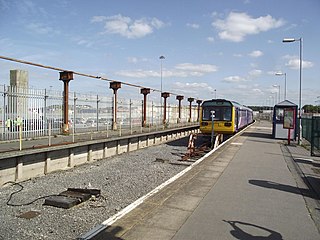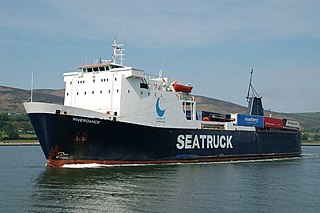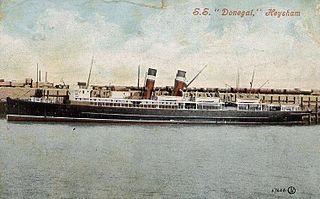
Heysham Port is a railway station on the Morecambe Branch Line, which runs between Lancaster and Heysham Port. The station, situated 7+3⁄4 miles (12 km) west of Lancaster, serves Heysham Port in Lancashire. It is owned by Network Rail and managed by Northern Trains.

The Dee Why and Curl Curl, were two identical steam ferries servicing Sydney Harbour's Circular Quay to Manly service. Both commissioned in 1928, they were the largest ferries on Sydney Harbour until the 1938 introduction of the South Steyne.

TSS Duke of Lancaster is a former railway steamer passenger ship that operated in Europe from 1956 to 1979, and is currently beached near Mostyn Docks, on the River Dee, north-east Wales. It replaced an earlier 3,600-ton ship of the same name operated by the London Midland and Scottish Railway company between Heysham and Belfast.

Riverdance was a roll-on/roll-off ferry in service with Seatruck Ferries on the Irish Sea. On 31 January 2008 she was hit by a wave that caused her cargo to shift and she beached at Blackpool, very close to the boundary with Cleveleys. Large amounts of the ship's cargo was spilled overboard after the ship ran aground, resulting in much of it being salvaged by members of the public. Attempts to refloat her failed, and she was scrapped on site during 2008.
Seatruck Ferries is a UK-based freight-only ferry company which commenced services in 1996. It is part of the Clipper Group, a shipping company based in The Bahamas. The company operates out of four ports on the Irish Sea, including Heysham and Liverpool.
Blackpool and the Fylde coast has become a ship graveyard to a number of vessels over the years. Most of the shipwrecks occurred at or near Blackpool, whilst a few happened a little further afield but have strong connections with the Blackpool area. For the purposes of this article, Blackpool means the stretch of coast from Fleetwood to Lytham St Annes.

MS Arrow is a 7,606 GT Ro-Ro ferry built by Astilleros de Huelva SA, Huelva, Spain in 1998 as Varbola for the Estonian Shipping Company, Tallinn. During a charter to Dart Line she was renamed Dart 6, reverting to Varbola when the charter ended. In 2005, she was sold to Malta and renamed RR Arrow. In 2007, she was sold to Seatruck Ferries, Heysham and renamed Arrow.
Arpha was a 602 GRT passenger ferry built in 1900 as Canterbury for the South Eastern and Chatham Railway. She passed to the Southern Railway on 1 January 1923. She was sold to W E Guinness in 1926 and renamed Arpha. In 1938 she was sold to Sark Motorships Ltd, only to be requisitioned by the Royal Navy in 1939. Postwar, she was sold to Compania Shell de Venezuela and renamed Coriano. After a further change of ownership she was scrapped in 1955.

The Queen was an English Channel passenger ferry that was built in 1903 and sunk in 1916. She was the South Eastern and Chatham Railway (SECR)'s first steam turbine ship.
The Duke of Argyll was a railway steamer passenger ship that operated in Europe from 1956 to 1975.

The Duke of Rothesay was a railway steamer passenger ship that operated in Europe from 1956 to 1975.

RMS Duke of Argyll was an Irish Sea ferry that operated from 1928 to 1956. William Denny and Brothers of Dumbarton on the Firth of Clyde built her for the London Midland and Scottish Railway. When the LMS was nationalised in 1948 she passed to the British Transport Commission.
The RMS Duke of Rothesay was a steamer passenger ship operated by the London Midland and Scottish Railway from 1928 to 1956.
The Duke of York was a steamer passenger ship initially operated by the London Midland and Scottish Railway which saw service from 1935 to 1964. She was renamed HMS Duke of Wellington for the duration of World War II.

TS Duchess of Montrose was a Clyde passenger steamer, built in 1930 for the Caledonian Steam Packet Company. She was a popular boat, providing day cruises until 1964.

SS (RMS) Douglas (III) – the third vessel in the line's history to bear the name – was a packet steamer which entered service with the London and South Western Railway in 1889 under the name Dora until she was purchased by the Isle of Man Steam Packet Company in 1901 for £13,500.

SS (RMS) Victoria was a packet steamer originally owned and operated by the South Eastern and Chatham Railway Company, who sold her to the Isle of Man Steam Packet Company in 1928 for the sum of £25,000.

The passenger steamer SS Peel Castle was operated by the Isle of Man Steam Packet Company from her purchase in 1912 until she was sold for breaking in 1939.

SS Donegal was a Midland Railway passenger ferry that served in the First World War as an ambulance ship. She was completed in 1904 and sunk by enemy action in April 1917.












